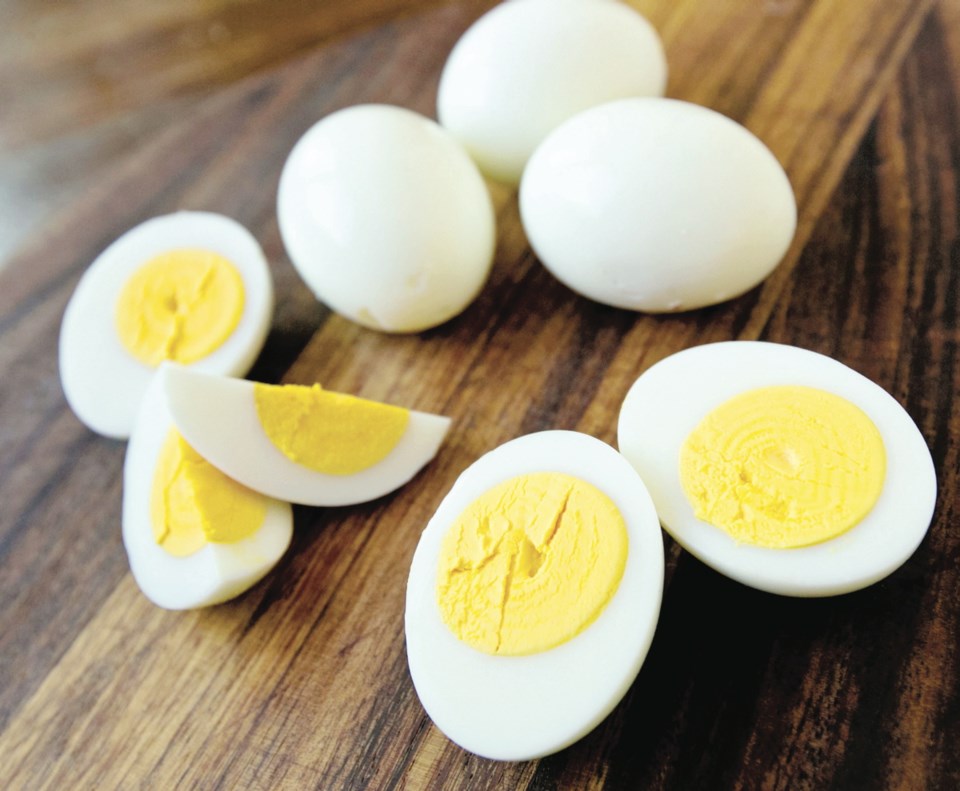 Dear Eric: I enjoyed an article you published many years ago on cooking the perfect hard-cooked egg. Please let me know how this is done again.
Dear Eric: I enjoyed an article you published many years ago on cooking the perfect hard-cooked egg. Please let me know how this is done again.
Michael
As I noted in the article (2005) Michael spoke of, I’ve tried a few methods for making hard-boiled eggs, also called hard-cooked eggs, over the years. My goal with my experimentation was to end up with a reliable way of cooking them.
In other words, I wanted a method in which each time out they ended up hard-boiled, not undercooked and runny. The centres also had to be golden, with not even a tinge of that horrid-looking iron green, grey colour that occurs when boiled eggs are overcooked.
When I wrote that original story, I noticed several sources said that to achieve the perfect hard-boiled egg you should bring cold water-covered eggs to a boil. You then take them off the heat and let them sit in the water for a specific amount of time. I use the word “specific,” because how long the eggs should sit did vary, sometimes quite a bit.
For example, on Martha Stewart’s website, marthastewart.com, it says to hard-cook eggs, place them in a deep saucepan and cover with cold water by one inch. It then instructs you to bring them to a boil over high heat, cover, remove from the heat and let them stand for 13 minutes.
After those 13 minutes, lift the eggs out of the pan with a slotted spoon and set them in an ice-water bath to stop the cooking. You can then lift the eggs out and serve them warm, or leave in the bath to cool completely, about 10 minutes.
The Egg Farmers of Canada website, , says that to make the perfect hard- boiled egg, you too should start by placing them in a pot and covering them with a similar amount of cold water.
Cover the pot, set it over high heat and bring the water to a rolling boil. You then remove them from the heat and, for large eggs, let them sit 20 minutes, seven minutes longer than Martha Stewart’s website advised.
After those 20 minutes, run cold water over the eggs until cooled. The website says the rapid cooling helps to prevent a green ring from forming around the yolks.
It’s been a while, so I decided to try this boil-and-let-sit method again to determine why it was not my preferred way to hard-boil eggs.
Martha Stewart’s eggs turned out just the tiniest bit under-done. While the eggs that sat for seven minutes longer were — surprisingly, given how much longer they sat in the hot water — just a bit overdone, with the outer edges of the yolks turning slightly greenish.
Although the methods above worked OK, to me they were not the perfect method for making hard-boiled eggs in that there were other variables that could affect how they turned out.
For example, when I tried both methods using a sturdy, heavy-bottomed pot, which retains heat well, the water in the pot stayed hotter longer and the eggs were sometimes overcooked, especially those that were to sit 20 minutes.
When I use a more flimsy pot that does not retain heat well, the eggs cooled down more quickly and, in some cases, were underdone. How many eggs I tried to cook at one time and the volume of water used also affected doneness level.
It’s that unpredictability in how the eggs turned out — especially when I needed easy-to-peel, perfectly cooked hard-boiled eggs for such things as deviled eggs, sandwiches or potato salad — that I came up with the method below to achieve that goal. In it you do actually boil the eggs, not just bring them to a boil. Every time I use this method, which I’ve fine-tuned slightly over the years, my eggs turn out perfectly hard-boiled:
• Place the large eggs you want to cook in a pot and cover with cold water by at least one inch.
Bring to a gentle boil over medium-high heat. The surface of the water should be just moving, with small bubbles rising and breaking on the surface.
• Adjust the heat as needed to maintain that gentle boil. (Don’t vigorously boil the eggs, as they could bounce around and crack and/or cook unevenly).
Now, set a timer for nine minutes. Some hard-boiled egg recipes call for 10 minutes of boiling time, but nine minutes is adequate.
• When nine minutes are up, immediately remove eggs from the heat and drain the hot water. Now, fill the pot with ice-cold water.
• Let the eggs sit in the water for just three minutes, to stop the cooking, and then start peeling. During this three minutes of cooling time, the eggs will contract a tiny bit from the shell, and still be a little warm, both of which will make them easier to peel.
• To peel an egg, gently tap and crack the egg on the bottom and top of the shell. Now, gently roll between your hands and then peel, beginning at the large end. If the shell is hard to get off in spots, dip it back into the water, or gently run some cold water over it.
Eric Akis is the author of The Great Rotisserie Chicken Cookbook (Appetite by Random House). His columns appear in the Life section Wednesday and Sunday.



